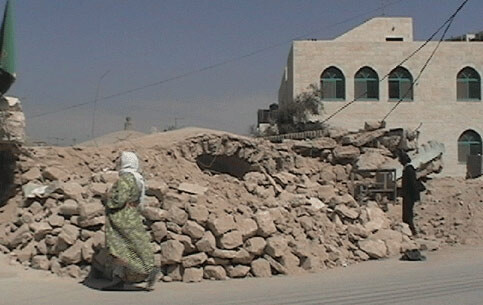13 May 2004

Al-Khadra Mosque: The oldest mosque in Nablus, the Al-Khadra Mosque was converted from a church to a mosque in 1187. It consists of a Mamluk minaret, intricate details of stone and hand-carved wooden doors. The main prayer hall (150 square meters) was destroyed and parts of the roof at the western side collapsed as a result of Israeli bombardment (Photo: Arjan El Fassed)
On the occasion of the fiftieth anniversary of the 1954 Hague Convention on the Protection of Cultural Property During Times of War and its Protocol, Al-Haq calls on the international community to uphold their obligations to ensure the protection of cultural heritage in the Occupied Palestinian Territories (OPT).
The last two years have seen a grave escalation in damage to cultural heritage in the OPT and the scale of destruction has been unprecedented. During April 2002, Israeli occupying forces destroyed large sections of the historic Old City of Nablus as well as parts of Bethlehem and Hebron during “Operation Defensive Shield.” Such attacks have not been limited to 2002, as Israeli military operations have become a regular occurrence in Nablus. Attacks on such a scale are a clear violation of Article 4(3) of the 1954 Hague Convention, which prohibits the pillage, destruction or damage of cultural property, and reprisals against cultural property, and a grave breach of the Fourth Geneva Convention. Israel is also in breach of its obligation under Article 5(2) of the 1954 Hague Convention to take measures to preserve cultural property damaged by military operations.

A view through an alley in the Old City of Nablus. The rubble is from a bakery, blown up by Israeli occupying forces during the April invasion of 2002 (Photo: Arjan El Fassed)
During the last year, the construction of the Annexation Wall has added a further threat to cultural heritage in the OPT and further restricted the cultural rights of Palestinians. The Wall, which does not follow the Green Line (the de facto border between Israel and the OPT) but annexes large amounts of Palestinian land, will isolate 40% of the OPT’s archaeological heritage on its western side. Its construction has destroyed archaeological sites such as the Byzantine site of Khirbet Salah in Abu Dis. By isolating some Palestinian villages and cutting off Jerusalem from the rest of the West Bank, the Wall excludes man-made and natural resources (such as olive trees); threatens the very existence of affected villages; isolates Palestinians from Jerusalem and its holy sites; and devastates the region’s landscape.
Through these and other actions, Israel continues to violate its international obligations concerning the protection of cultural heritage in the OPT. Israel’s unlawful practices in the OPT have resulted in the destruction of traditional Palestinian villages; plunder, destruction and damage of archaeological sites; destruction of monuments and historical buildings; and destruction of the landscape and natural environment, notably due to the continuous building of settlements and by-pass roads. These practices are serious violations of their obligations under the 1954 Hague Convention and its Protocol, under which an Occupying Power has clear international obligations concerning cultural property within occupied territories, including the positive obligation to prosecute persons who violate their provisions.
Israeli actions are complete contradictory to the increasing international awareness of the need for greater protection of cultural property. The international community has embraced the need for such protection through the March 2004 entry into force of the Second Protocol (listing those acts that entail individual criminal responsibility) and the development of case law in this area, notably by the International Criminal Tribunal for the former Yugoslavia. As the United Nations Educational, Scientific and Cultural Organisation (UNESCO) Director-General Koïchiro Matsuura noted, “it shows that the international community will not sit idly by and condone crimes against cultural property.”[1] This awareness was also reflected in the international outcry following the Taliban’s destruction of the Buddhas of Bamiyan.
Al-Haq called on the international community to take action and stop Israeli forces from further violating cultural heritage in the OPT. Some voices, such as the World Heritage Committee, the International Committee of the Blue Shield (ICBS) and the World Archaeological Congress, have already raised their concerns. We take the opportunity of the anniversary of the 1954 Hague Convention to also raise ours and send an urgent alert to act to stop this destruction. The ongoing loss of parts of this heritage is a great loss for all and the international community as a whole has a responsibility to act to prevent it.
We call upon Israel to fully respect the full provisions of the 1954 Hague Convention and all other relevant treaties related to the cultural heritage; to immediately stop the destruction, attack and plunder of the cultural heritage in the OPT; to bring those responsible for the destruction of cultural heritage in the OPT to justice; and to stop the construction of the Annexation Wall and dismantle its existing sections.
We call upon the international community to use all available means to stop the destruction of cultural heritage in the OPT.
We call for the assistance of the ICBS, the cultural equivalent of the International Committee of the Red Cross, to intervene in the OPT.
We call upon UNESCO to denunciate and investigate the practices of the Israeli occupying forces in the OPT.
For more information, see also: Al-Haq, Plunder, Destruction and Despoliation: An Analysis of Israel’s Violations of the International Law of Cultural Property in the Occupied West Bank and Gaza Strip (May 1997)
Related Links